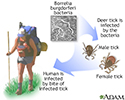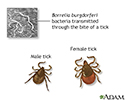Lyme disease - what to ask your doctor
What to ask your doctor about Lyme disease; Lyme borreliosis - questions; Bannwarth syndrome - questions
Lyme disease is a bacterial infection that is spread through the bite of one of several types of ticks. The disease can cause symptoms including bull's eye rash, chills, fever, headache, fatigue, and muscle pain.
Lyme disease
Lyme disease is a bacterial infection that is spread through the bite of one of several types of ticks.

Below are some questions you may want to ask your health care provider about Lyme disease.
Questions
Where on my body am I most likely to get a tick bite?
- How large are ticks and tick bites? If I have a tick bite, will I always get Lyme disease?
- Can I get Lyme disease even if I never noticed a tick bite on my body?
- What can I do to prevent getting tick bites when I am in a wooded or grassy area?
- In what areas of the US am I more likely to get a tick bite or Lyme disease? At what time of the year is the risk higher?
- Should I remove a tick if I find one on my body? What is the proper way to remove a tick? Should I save the tick?
If I get Lyme disease from a tick bite, what symptoms will I have?
- Will I always have symptoms soon after getting Lyme disease (early or primary Lyme disease)? Will these symptoms get better if I am treated with antibiotics?
- If I do not get symptoms right away, can I get symptoms later? How much later? Are these symptoms the same as the early symptoms? Will these symptoms get better if I am treated with antibiotics?
- If I am treated for Lyme disease, will I ever have symptoms again? If I do, will these symptoms get better if I am treated with antibiotics?
How can my doctor diagnose me with Lyme disease? Can I be diagnosed even if I do not remember having a tick bite?
What are the antibiotics used to treat Lyme disease? How long do I need to take them? What are the side effects?
Will I have a full recovery from my Lyme disease symptoms?
References
Centers for Disease Control and Prevention. Lyme disease. Updated August 19, 2016. www.cdc.gov/lyme . Accessed October 27, 2016.
Steere AC. Lyme disease (Lyme Borreliosis) due to Borrelia burgdorferi. In: Bennett JE, Dolin R, Blaser MJ, eds. Mandell, Douglas, and Bennett's Principles and Practice of Infectious Diseases, Updated Edition . 8th ed. Philadelphia, PA: Elsevier Saunders; 2015:chap 243.
Wormser GP. Lyme disease. In: Goldman L, Schafer AI, eds. Goldman's Cecil Medicine . 25th ed. Philadelphia, PA: Elsevier Saunders; 2016:chap 321.
-
Lyme disease - illustration
Lyme disease is an acute inflammatory disease characterized by skin changes, joint inflammation and symptoms similar to the flu that is caused by the bacterium Borrelia burgdorferi. Lyme disease is transmitted by the bite of a deer tick. Symptoms resolve in 3 to 4 weeks even without treatment, but secondary or tertiary disease may develop if initial infection is not treated. Borrelia burgdorferi
Lyme disease
illustration
-
Tertiary Lyme disease - illustration
Tertiary Lyme disease is a late, persistent inflammatory disease characterized by skin changes, neurological and musculoskeletal symptoms caused by the bacterium Borrelia burgdorferi transmitted by the bite of a tick. Tertiary Lyme disease is indicated by chronic arthritis. Borrelia burgdorferi
Tertiary Lyme disease
illustration
-
Lyme disease - illustration
Lyme disease is an acute inflammatory disease characterized by skin changes, joint inflammation and symptoms similar to the flu that is caused by the bacterium Borrelia burgdorferi. Lyme disease is transmitted by the bite of a deer tick. Symptoms resolve in 3 to 4 weeks even without treatment, but secondary or tertiary disease may develop if initial infection is not treated. Borrelia burgdorferi
Lyme disease
illustration
-
Tertiary Lyme disease - illustration
Tertiary Lyme disease is a late, persistent inflammatory disease characterized by skin changes, neurological and musculoskeletal symptoms caused by the bacterium Borrelia burgdorferi transmitted by the bite of a tick. Tertiary Lyme disease is indicated by chronic arthritis. Borrelia burgdorferi
Tertiary Lyme disease
illustration
-
Lyme disease
(Alt. Medicine)
-
Flaxseed
(Alt. Medicine)
-
Systemic lupus erythematosus
(In-Depth)
-
Multiple sclerosis
(In-Depth)
-
Uveitis
(Alt. Medicine)
-
Osteoarthritis
(In-Depth)
Review Date: 8/22/2016
Reviewed By: Laura J. Martin, MD, MPH, ABIM Board Certified in Internal Medicine and Hospice and Palliative Medicine, Atlanta, GA. Also reviewed by David Zieve, MD, MHA, Isla Ogilvie, PhD, and the A.D.A.M. Editorial team.


